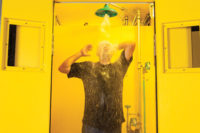QUESTION:
How can I be assured that our facility’s emergency equipment is being properly maintained and is in proper working order for when we need it?ANSWERS:
The best way to ensure that your equipment is in proper working order and ready for a potential emergency is to perform weekly and annual testing as required by ANSI Z358.1-2004. According to the Z358.1 standard, plumbed equipment should be activated weekly for a period long enough to verify operation and ensure that flushing fluid is available. The plumbed equipment should be inspected on an annual basis to make sure it is in conformance with Z358.1.Imants Stiebris, Business Leader, Speakman Safety Products
Emergency equipment must be regularly maintained to guarantee employees a safe working environment and fast treatment. According to the American National Standard for Emergency Eyewash and Shower Equipment Z358.1-2004, plumbed emergency fixtures must be tested weekly. Look for leaks, obstruction of flow and damaged parts. Running water through weekly will keep the system lubricated. Inspect fixtures annually for proper flow rate, spray pattern and incoming pressure. Units should activate in one second or less, and the valve should stay open until manually turned off. Water temperature should be tepid and supply constant.
Rebecca Geissler, Product Manager for Emergency Fixtures, Bradley Corp.
Per ANSI Z358.1-2004, it is important to realize that there are really several purposes for the weekly inspections, including assuring:
1) that there is an adequate water supply to the equipment;
2) that the equipment is flushed out and functioning properly; and
3) that access to the equipment is not hampered in any way.
Objectively assess your readiness with respect to all three of these aspects on a weekly basis.
Casey Hayes, Engineering Manager, Haws Corp.
The maintenance department should test all emergency equipment weekly, as required by ANSI Z358.1, and document the date of testing on an “Inspection Log†attached to the equipment. A routine management audit of the “Inspection Log†tags will assure procedures are adhered to.
Carsten Birch, General Manager, Guardian Equipment
For functional verification of emergency shower and eyewash equipment, the most often used guideline is the ANSI Z358.1-2004 standard. Here it is recommended that the units be installed to the manufacturer’s instructions and then have flushing fluid performance verified as meeting this ANSI standard. The expected flow rates and flushing fluid patterns are described in written word and illustrations that help the reader understand how the equipment should operate.
The maintenance program should include weekly inspection, and for plumbed units a verification of flow of flushing fluid. An annual inspection should be performed by a qualified person familiar with the standard.
Jim Johnson, Vice President, Emergency Shower and Eyewash, Encon Safety Products
Scheduled maintenance of eyewash devices is essential. ANSI Z358.1-2004 requires plumbed units be activated weekly to verify proper operation. Self-contained, gravity-fed eyewash devices must be maintained according to manufacturer’s instructions.
Fluid changes for devices using water mixed with a preservative or factory prepared liquid concentrate range from 1–6 months. Factory-sealed fluid cartridges offer low maintenance changing every 24 months unless activated sooner. It’s important to check expiration dates on product packaging to determine maintenance frequency for the solution used.
Christine L. Mello, Product Manager, Fend-all, A Bacou-Dalloz Company
As with all plant equipment, establish a regular care and maintenance program using any established industry/government standards as a guideline. But do not stop there — train all shift crews on the use, care and basic maintenance of the products since emergencies tend to happen when least expected and always at the worst time.
Mark Conron, President, FSI North Americaâ„¢, A Division of Fire Safety International, Inc.â„¢
The OSHA regulation regarding emergency equipment is quite vague, in that it does not define what constitutes “suitable facilities†for drenching the eyes or body. A common reference point when specifying emergency equipment is ANSI Z358.1. This standard is a widely accepted guideline for the proper selection, installation and maintenance of emergency equipment.
Melissa Pansino, Marketing Coordinator, Sellstrom Manufacturing Co.

